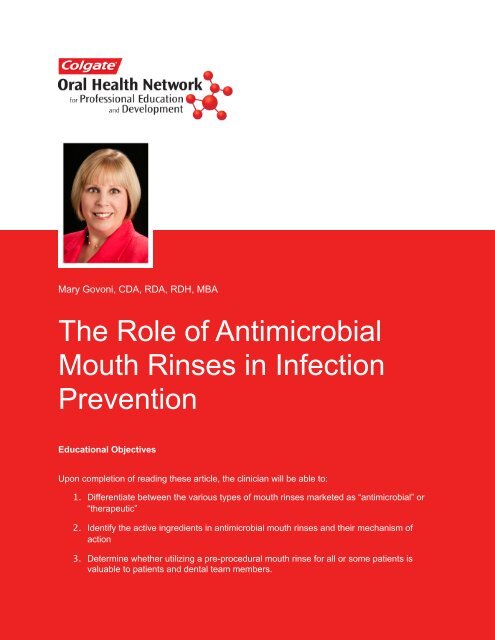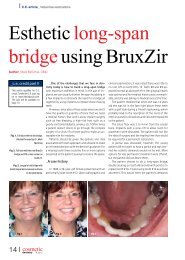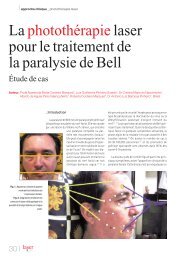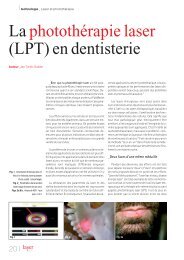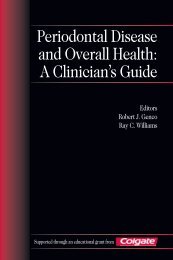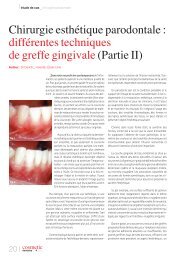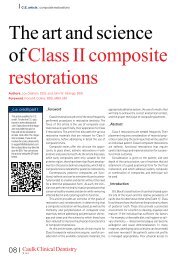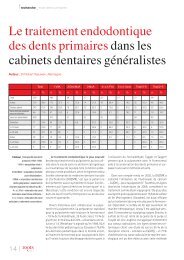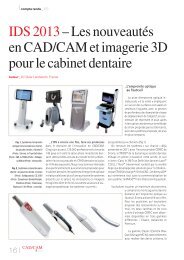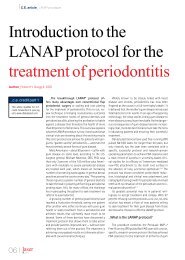The Role of Antimicrobial Mouth Rinses in Infection Prevention
The Role of Antimicrobial Mouth Rinses in Infection Prevention
The Role of Antimicrobial Mouth Rinses in Infection Prevention
Create successful ePaper yourself
Turn your PDF publications into a flip-book with our unique Google optimized e-Paper software.
Mary Govoni, CDA, RDA, RDH, MBA<br />
<strong>The</strong> <strong>Role</strong> <strong>of</strong> <strong>Antimicrobial</strong><br />
<strong>Mouth</strong> <strong>R<strong>in</strong>ses</strong> <strong>in</strong> <strong>Infection</strong><br />
<strong>Prevention</strong><br />
Educational Objectives<br />
Upon completion <strong>of</strong> read<strong>in</strong>g these article, the cl<strong>in</strong>ician will be able to:<br />
1. Differentiate between the various types <strong>of</strong> mouth r<strong>in</strong>ses marketed as “antimicrobial” or<br />
“therapeutic”<br />
2. Identify the active <strong>in</strong>gredients <strong>in</strong> antimicrobial mouth r<strong>in</strong>ses and their mechanism <strong>of</strong><br />
action<br />
3. Determ<strong>in</strong>e whether utiliz<strong>in</strong>g a pre-procedural mouth r<strong>in</strong>se for all or some patients is<br />
valuable to patients and dental team members.
Introduction<br />
<strong>Mouth</strong> r<strong>in</strong>ses have been studied extensively for their potential benefits to patients for disease<br />
prevention, as well as the benefit to dental health pr<strong>of</strong>essionals for their potential to reduce<br />
exposure to oral microorganisms dur<strong>in</strong>g dental procedures.<br />
<strong>The</strong> studies have focused on three key areas. <strong>The</strong> first is the role <strong>of</strong> antimicrobial r<strong>in</strong>ses <strong>in</strong><br />
treatment and prevention <strong>of</strong> periodontal disease by kill<strong>in</strong>g or <strong>in</strong>hibit<strong>in</strong>g the growth <strong>of</strong> bacteria that<br />
cause g<strong>in</strong>givitis and periodontitis. Second is their role <strong>in</strong> the prevention <strong>of</strong> bacteremia, by<br />
reduc<strong>in</strong>g the number <strong>of</strong> microorganisms <strong>in</strong> the oral cavity which might be <strong>in</strong>troduced <strong>in</strong>to the<br />
bloodstream dur<strong>in</strong>g dental procedures. <strong>The</strong> third is <strong>in</strong>fection prevention and safety for the dental<br />
team and patients by reduc<strong>in</strong>g the number <strong>of</strong> microorganisms <strong>in</strong> saliva that may become<br />
airborne dur<strong>in</strong>g dental procedures.<br />
In addition, the types <strong>of</strong> antimicrobial agents <strong>in</strong> the mouthr<strong>in</strong>ses have also been studied and<br />
compared for their effectiveness <strong>in</strong> reduc<strong>in</strong>g microorganisms, as well as potential side effects <strong>of</strong><br />
us<strong>in</strong>g the r<strong>in</strong>ses. This course will exam<strong>in</strong>e the uses <strong>of</strong> antimicrobial mouth r<strong>in</strong>ses prior to dental<br />
procedures and the potential benefits to both patients and dental health pr<strong>of</strong>essionals. In order<br />
to understand the value <strong>of</strong> antimicrobial mouthr<strong>in</strong>ses, it is important to understand the types <strong>of</strong><br />
r<strong>in</strong>ses available and their mechanism <strong>of</strong> action.<br />
Types <strong>of</strong> <strong>Mouth</strong> <strong>R<strong>in</strong>ses</strong><br />
<strong>Mouth</strong> r<strong>in</strong>ses are available <strong>in</strong> over-the-counter (OTC) formulations as well as <strong>in</strong> prescription-only<br />
formulations. Oral r<strong>in</strong>ses can be categorized by their <strong>in</strong>gredients or mode <strong>of</strong> action. For<br />
example, many OTC mouth r<strong>in</strong>ses are meant to be cosmetic – to freshen breath, or whiten<br />
teeth. <strong>The</strong>y conta<strong>in</strong> active <strong>in</strong>gredients, such as flavor<strong>in</strong>g oils and/or hydrogen peroxide, which is<br />
a whiten<strong>in</strong>g agent. Other OTC r<strong>in</strong>ses are categorized as therapeutic, mean<strong>in</strong>g that they conta<strong>in</strong><br />
an <strong>in</strong>gredient that is meant to protect aga<strong>in</strong>st disease, such as caries or g<strong>in</strong>givitis. <strong>The</strong>se r<strong>in</strong>ses<br />
may conta<strong>in</strong> fluoride or other <strong>in</strong>gredients, such as chlorhexad<strong>in</strong>e (CHX) or cetylpyrid<strong>in</strong>ium<br />
chloride (CPC), or essential oils, which we will discuss later. Many <strong>of</strong> the OTC oral r<strong>in</strong>ses are a<br />
comb<strong>in</strong>ation <strong>of</strong> both cosmetic and therapeutic characteristics, while the prescription r<strong>in</strong>ses<br />
typically conta<strong>in</strong> one key active <strong>in</strong>gredient, such as fluoride or CHX. Table 1 compares the<br />
characteristics <strong>of</strong> cosmetic and therapeutic oral r<strong>in</strong>ses.<br />
<strong>The</strong>rapeutic oral r<strong>in</strong>ses are regulated by the Food and Drug Adm<strong>in</strong>istration (FDA), whether they<br />
are OTC or prescription-only. In order to make a claim that a product has therapeutic value, it<br />
must go through rigorous test<strong>in</strong>g by the FDA to prove its safety and efficacy. <strong>The</strong> FDA has taken<br />
action aga<strong>in</strong>st some manufacturers <strong>of</strong> mouth r<strong>in</strong>ses for unsubstantiated claims <strong>of</strong> effectiveness<br />
<strong>in</strong> prevent<strong>in</strong>g plaque formation and antimicrobial activity. <strong>The</strong>se r<strong>in</strong>ses are approved as<br />
antimicrobial “drugs”, s<strong>in</strong>ce they act chemically to kill bacteria. In addition to FDA approval, OTC<br />
therapeutic oral r<strong>in</strong>ses may also receive the Seal <strong>of</strong> Acceptance from the American Dental<br />
Association (ADA), which is a voluntary acceptance or approval for products that have met<br />
www.ColgateOralHealthNetwork.com<br />
Web<strong>in</strong>ars | On-Demand Courses | Articles | Textbooks 2
certa<strong>in</strong> safety and efficacy requirements. Additional <strong>in</strong>formation regard<strong>in</strong>g the FDA approval<br />
process is available at: http://www.fda.gov/MedicalDevices/ProductsandMedicalProcedures/<br />
DeviceApprovalsandClearances/default.htm. And <strong>in</strong>formation regard<strong>in</strong>g the ADA Seal program<br />
is available at: http://www.ada.org/sealprogramproducts.aspx.<br />
It should be noted that the FDA has also approved a r<strong>in</strong>se that forms a physical barrier on teeth<br />
– a surfactant – that prevents the attachment <strong>of</strong> plaque bacteria on tooth surfaces, mak<strong>in</strong>g it<br />
easier to remove. This type <strong>of</strong> r<strong>in</strong>se, which conta<strong>in</strong>s Delmop<strong>in</strong>ol, is approved by the FDA as a<br />
medical device, s<strong>in</strong>ce its action is physical rather than chemical. It is available as an OTC r<strong>in</strong>se.<br />
While the studies show positive results with this type <strong>of</strong> r<strong>in</strong>se,, its action is not one that would<br />
lend itself to use as a pre-procedural mouthr<strong>in</strong>se, s<strong>in</strong>ce it does not kill microorganisms.<br />
S<strong>in</strong>ce many therapeutic mouthr<strong>in</strong>ses claim to kill or <strong>in</strong>hibit the growth <strong>of</strong> microorganisms that<br />
cause periodontal disease, some may be further categorized as antimicrobial oral r<strong>in</strong>ses. <strong>The</strong>se<br />
types <strong>of</strong> r<strong>in</strong>ses typically conta<strong>in</strong> one <strong>of</strong> three active <strong>in</strong>gredients: chlorhexad<strong>in</strong>e gluconate (CHX),<br />
cetylpyrid<strong>in</strong>ium chloride (CPC) or essential oils – conta<strong>in</strong><strong>in</strong>g r<strong>in</strong>ses. <strong>The</strong> essential oil r<strong>in</strong>ses,<br />
sometimes referred to as phenolics, may conta<strong>in</strong> <strong>in</strong>gredients such as thymol, menthol,<br />
eucalyptol, or eugenol; alone or <strong>in</strong> comb<strong>in</strong>ation. <strong>The</strong>se antimicrobial oral r<strong>in</strong>ses have been<br />
studied extensively for safety and efficacy with regard to treatment and prevention <strong>of</strong> periodontal<br />
disease, their potential for reduc<strong>in</strong>g bacteremia dur<strong>in</strong>g dental procedures and for their potential<br />
for reduc<strong>in</strong>g the number <strong>of</strong> microorganisms <strong>in</strong> the splash, splatter or aerosol <strong>of</strong> saliva dur<strong>in</strong>g<br />
dental procedures. <strong>The</strong> research strongly supports the <strong>in</strong>corporation <strong>of</strong> antimicrobial mouth<br />
r<strong>in</strong>ses <strong>in</strong>to the oral hygiene protocol for patients who have g<strong>in</strong>givitis and periodontitis., In<br />
addition, these r<strong>in</strong>se agents are <strong>of</strong>ten used as irrigat<strong>in</strong>g solutions dur<strong>in</strong>g dental hygiene<br />
procedures, such as ultrasonic scal<strong>in</strong>g. Table 2 lists common brands <strong>of</strong> therapeutic r<strong>in</strong>ses and<br />
their active <strong>in</strong>gredients.<br />
Comparison <strong>of</strong> Active Ingredients <strong>in</strong> <strong>The</strong>rapeutic Oral <strong>R<strong>in</strong>ses</strong><br />
Chlorhexad<strong>in</strong>e gluconate (CHX) is an antiseptic – a cationic bis-biguanide that is used for<br />
numerous applications. In dentistry it is used as a dental unit waterl<strong>in</strong>e dis<strong>in</strong>fectant, as a gelat<strong>in</strong>like<br />
chip for placement <strong>in</strong>to periodontal pockets at high concentration <strong>of</strong> 36% and as a mouth<br />
r<strong>in</strong>se at lower concentration <strong>of</strong> 0.12% <strong>in</strong> the United States. <strong>The</strong> CHX oral r<strong>in</strong>se is a prescriptiononly<br />
product that has been widely prescribed for periodontal patients for a number <strong>of</strong> years and<br />
its effectiveness is well documented.<br />
It is effective on both gram-positive and gram-negative bacteria, which is particularly beneficial<br />
<strong>in</strong> prevention <strong>of</strong> plaque formation, which is normally composed <strong>of</strong> gram-positive bacteria and is<br />
a key factor <strong>in</strong> the development <strong>of</strong> g<strong>in</strong>givitis and its progression to periodontitis, <strong>in</strong> which grampositive<br />
bacteria and gram-negative bacteria are present. Chlorhexad<strong>in</strong>e gluconate works by<br />
adsorption <strong>in</strong>to the pellicle on tooth enamel, to the hydroxyapatite <strong>of</strong> the enamel, to plaque<br />
bacteria and mucous membranes, which provides a long-last<strong>in</strong>g bacteriostatic and bactericidal<br />
effect, <strong>in</strong>hibit<strong>in</strong>g bacterial colonization <strong>of</strong> plaque. CHX r<strong>in</strong>ses come <strong>in</strong> both alcohol and alcoholwww.ColgateOralHealthNetwork.com<br />
Web<strong>in</strong>ars | On-Demand Courses | Articles | Textbooks 3
free formulas. Alcohol is not an active <strong>in</strong>gredient <strong>in</strong> the r<strong>in</strong>se, but is a solubilizer or delivery<br />
vehicle for the other <strong>in</strong>gredients. Some patients are sensitive to the burn<strong>in</strong>g sensation <strong>of</strong><br />
alcohol-conta<strong>in</strong><strong>in</strong>g mouth r<strong>in</strong>ses, especially if they experience xerostomia. In addition, patients<br />
who have issues with alcohol abuse are not candidates for use <strong>of</strong> alcohol-conta<strong>in</strong><strong>in</strong>g mouth<br />
r<strong>in</strong>ses. Long term use <strong>of</strong> CHX oral r<strong>in</strong>ses has been shown to cause brownish discoloration <strong>of</strong><br />
the teeth and some restorations, as well as some sta<strong>in</strong><strong>in</strong>g <strong>of</strong> the tongue and g<strong>in</strong>giva. It should<br />
be noted, however, that heavy sta<strong>in</strong><strong>in</strong>g on teeth has been shown to be associated with<br />
unremoved plaque, which can be decreased with improved oral hygiene. It can also cause a<br />
change <strong>in</strong> taste perception for some patients.<br />
Cetylpyrid<strong>in</strong>ium chloride (CPC) is also an antiseptic – a cationic quaternary ammonium<br />
compound which is used <strong>in</strong> products such as toothpaste, nasal sprays, and more recently <strong>in</strong><br />
mouth r<strong>in</strong>ses <strong>in</strong> a .45% to 10% concentration. CPC r<strong>in</strong>ses are more recent additions to the<br />
antimicrobial therapeutic r<strong>in</strong>se category and have also been extensively studied for their<br />
effectiveness, which is said to be comparable to CHX r<strong>in</strong>ses. In addition to the concentration <strong>of</strong><br />
the CPC <strong>in</strong> a therapeutic r<strong>in</strong>se, it is important that the other <strong>in</strong>gredients <strong>in</strong> the r<strong>in</strong>se, such as<br />
solubilizers (sometimes alcohol), preservatives and stabilizers do not have a negative effect on<br />
the bioavailability <strong>of</strong> the CPC. Higher bioavailability is will <strong>in</strong>crease the effectiveness <strong>of</strong> the r<strong>in</strong>se.<br />
CPC r<strong>in</strong>ses have been shown to prevent the formation <strong>of</strong> plaque and reduce g<strong>in</strong>givitis, a<br />
precursor to periodontitis, by penetrat<strong>in</strong>g the cell walls <strong>of</strong> bacteria, which causes leakage and<br />
eventually death <strong>of</strong> the bacteria. Like CHX, CPC is a long-act<strong>in</strong>g agent, shown to be bioactive <strong>in</strong><br />
the mouth for up to 12 hours after us<strong>in</strong>g the r<strong>in</strong>se due to its ability to adhere to the teeth. CPC<br />
mouth r<strong>in</strong>ses are also available <strong>in</strong> both alcohol and alcohol-free formulas. A dist<strong>in</strong>ct advantage<br />
<strong>of</strong> CPC mouthr<strong>in</strong>ses is that they are OTC products, mak<strong>in</strong>g them more readily available to<br />
patients.<br />
Essential Oils formulations are OTC r<strong>in</strong>ses. <strong>The</strong> essential oil formulation that has been<br />
approved by the FDA as a therapeutic oral r<strong>in</strong>se is that <strong>of</strong> Lister<strong>in</strong>e®, with a composition <strong>of</strong><br />
eucalyptol, menthol, methyl salicylate, and thymol which are delivered <strong>in</strong> an alcohol base.<br />
<strong>R<strong>in</strong>ses</strong> with essential oils as their active <strong>in</strong>gredients are able to disrupt cell membranes and also<br />
<strong>in</strong>hibit the enzyme activity <strong>of</strong> cells, which makes the products bacteriostatic or bactericidal.<br />
Because alcohol is the delivery vehicle for this formulation, patients may experience burn<strong>in</strong>g<br />
and it is not the most appropriate choice for patients with xerostomia or who are alcohol<br />
abusers. Essential oils r<strong>in</strong>ses have not been proven to have the adhesive properties <strong>of</strong> CHX and<br />
CPC products, therefore they have more limited bioavailability.<br />
<strong>Mouth</strong>r<strong>in</strong>ses and <strong>Prevention</strong> <strong>of</strong> Bacteremia<br />
<strong>Antimicrobial</strong> mouth r<strong>in</strong>ses used by the patient before a dental procedure can decrease the<br />
number <strong>of</strong> microorganisms <strong>in</strong>troduced <strong>in</strong>to the patient's bloodstream dur<strong>in</strong>g <strong>in</strong>vasive dental<br />
procedures. <strong>The</strong> scientific evidence is not clear, however, that reduc<strong>in</strong>g the number <strong>of</strong><br />
microorganisms through mouth r<strong>in</strong>s<strong>in</strong>g directly reduces the <strong>in</strong>cidence <strong>of</strong> bacteremia. In its 1997<br />
www.ColgateOralHealthNetwork.com<br />
Web<strong>in</strong>ars | On-Demand Courses | Articles | Textbooks 4
guidel<strong>in</strong>es for antibiotic prophylaxis, the American Heart Association (AHA) recommended the<br />
use <strong>of</strong> pre-procedural mouth r<strong>in</strong>ses for patients at risk for bacteremia dur<strong>in</strong>g dental procedures.<br />
In its most current guidel<strong>in</strong>es, the AHA does not mention pre-procedural mouth r<strong>in</strong>s<strong>in</strong>g. In<br />
addition, the American Academy <strong>of</strong> Orthopaedic Surgeons (AAOS) also states <strong>in</strong> their 2012<br />
guidel<strong>in</strong>es on <strong>Prevention</strong> <strong>of</strong> Orthopaedic Implant <strong>Infection</strong> <strong>in</strong> Patients Undergo<strong>in</strong>g Dental<br />
Procedures that the evidence is <strong>in</strong>conclusive to support the use <strong>of</strong> topical antimicrobials (mouth<br />
r<strong>in</strong>ses) to prevent orthopaedic implant <strong>in</strong>fections. Further study is needed to determ<strong>in</strong>e the<br />
effectiveness <strong>of</strong> pre-procedural mouth r<strong>in</strong>s<strong>in</strong>g for reduc<strong>in</strong>g dental procedure-<strong>in</strong>duced bacteremia<br />
and the <strong>in</strong>cidence <strong>of</strong> bacteremia <strong>in</strong> patients who have underly<strong>in</strong>g risks.<br />
<strong>Mouth</strong> <strong>R<strong>in</strong>ses</strong> for Environmental <strong>Infection</strong> Control<br />
<strong>The</strong> third issue related to pre-procedural mouth r<strong>in</strong>s<strong>in</strong>g is that <strong>of</strong> reduc<strong>in</strong>g the number <strong>of</strong> bacteria<br />
<strong>in</strong> the saliva dur<strong>in</strong>g dental procedures that <strong>in</strong>volve the creation <strong>of</strong> aerosols, spatter and spray.<br />
<strong>The</strong>se procedures <strong>in</strong>clude the use <strong>of</strong> a high and slow speed handpieces, air/water syr<strong>in</strong>ges and<br />
ultrasonic scalers. <strong>The</strong> most effective way to reduce the aerosol and spatter contam<strong>in</strong>ation is to<br />
use a dental dam. But a dental dam would <strong>in</strong>terfere with hygiene procedures, such as ultrasonic<br />
scal<strong>in</strong>g and polish<strong>in</strong>g. And the use <strong>of</strong> dental dam for restorative procedures may take additional<br />
time and <strong>in</strong>strumentation that many practices choose not to adapt <strong>in</strong>to their protocols. In this<br />
case, a pre-procedural antibacterial mouth r<strong>in</strong>se is a simple way to decrease the potential for<br />
aerosol contam<strong>in</strong>ation <strong>in</strong> the treatment rooms.<br />
While the Centers for Disease Control and <strong>Prevention</strong> (CDC) does not specifically recommend<br />
pre-procedural mouthr<strong>in</strong>ses as an <strong>in</strong>fection prevention protocol, there is evidence that us<strong>in</strong>g an<br />
antimicrobial mouthr<strong>in</strong>se prior to procedures can reduce the potential for is contam<strong>in</strong>ation <strong>of</strong><br />
equipment and environmental surfaces. Accord<strong>in</strong>g to the CDC, the spray from dental<br />
procedures typically conta<strong>in</strong>s large-particle spatter or spray <strong>of</strong> water, saliva, blood,<br />
microorganisms and other debris (tooth, restorative material, calculus). <strong>The</strong> spatter has been<br />
shown to travel only short distances from the patient’s mouth, which would potentially<br />
contam<strong>in</strong>ate equipment (e.g. bracket tray), operatory surfaces (counter tops or other work<br />
surfaces) and the dental team members and patients. Aerosol, on the other hand is composed<br />
<strong>of</strong> much smaller particles and can rema<strong>in</strong> airborne for long periods <strong>of</strong> time and can pose an<br />
<strong>in</strong>halation risk for dental team members. It is important to note, however, that there is no<br />
evidence <strong>of</strong> transmission <strong>of</strong> bloodborne pathogens, such as hepatitis B or C or HIV/AIDS<br />
through exposure to aerosol or spatter <strong>in</strong> dentistry. <strong>The</strong> use <strong>of</strong> pre-procedural mouthr<strong>in</strong>ses is an<br />
additional safeguard that could be employed by dental practices for protection aga<strong>in</strong>st other<br />
types <strong>of</strong> microorganisms, such as the <strong>in</strong>fluenza virus. But dental teams should utilize dental<br />
dams and high volume evacuation as their first l<strong>in</strong>e <strong>of</strong> defense aga<strong>in</strong>st spatter and<br />
aerosolization <strong>of</strong> saliva and blood dur<strong>in</strong>g dental procedures. It is also important to note that the<br />
use <strong>of</strong> pre-procedural mouthr<strong>in</strong>ses does not preclude the need for environmental clean<strong>in</strong>g and<br />
dis<strong>in</strong>fection <strong>of</strong> equipment and surfaces follow<strong>in</strong>g treatment. Although the mouthr<strong>in</strong>se may<br />
www.ColgateOralHealthNetwork.com<br />
Web<strong>in</strong>ars | On-Demand Courses | Articles | Textbooks 5
decrease the number <strong>of</strong> microorganisms, it does not reduce the spatter, unless high-volume<br />
suction or dental dam is used.<br />
S<strong>in</strong>ce hygiene procedures are the least likely to have high volume evacuation utilized, and the<br />
use <strong>of</strong> dental dam is not appropriate, pre-procedural mouthr<strong>in</strong>ses make the most sense for use<br />
prior to hygiene procedures. Not only can the mouthr<strong>in</strong>se reduce microorganisms, but it<br />
provides an excellent opportunity for the hygienist to <strong>in</strong>troduce the concept <strong>of</strong> utiliz<strong>in</strong>g an<br />
antimicrobial mouthr<strong>in</strong>se as part <strong>of</strong> rout<strong>in</strong>g oral health care for the patients. <strong>The</strong> hygienist has an<br />
opportunity to educate the patients about the benefits <strong>of</strong> antimicrobial r<strong>in</strong>ses <strong>in</strong> controll<strong>in</strong>g<br />
plaque formation and treat<strong>in</strong>g periodontal disease. <strong>The</strong> education process can also <strong>in</strong>clude<br />
<strong>in</strong>formation about the most appropriate antimicrobial r<strong>in</strong>se for each patient, such as alcohol-free<br />
formulas, and the long last<strong>in</strong>g effects <strong>of</strong> CPC and CHX mouthr<strong>in</strong>ses. Hav<strong>in</strong>g the patient utilize<br />
the antimicrobial mouthr<strong>in</strong>se prior to a procedure is a strong endorsement <strong>of</strong> the belief <strong>in</strong> the<br />
therapeutic value <strong>of</strong> us<strong>in</strong>g the r<strong>in</strong>se and opens the door for additional dialogue with the patient<br />
about their oral health and the need to control oral microorganisms that can cause disease. It<br />
also provides the opportunity for the hygienist to differentiate between cosmetic and therapeutic<br />
mouthr<strong>in</strong>ses, the research that supports the use <strong>of</strong> therapeutic mouthr<strong>in</strong>ses and the benefits to<br />
the patient.<br />
Implementation <strong>of</strong> a Pre-Procedural <strong>Mouth</strong>r<strong>in</strong>se Protocol:<br />
If a practice implements a pre-procedural mouthr<strong>in</strong>se protocol, the first step is to decide if the<br />
protocol will apply to all procedures or just to hygiene procedures. Although the data <strong>in</strong>dicates<br />
that the most benefit is ga<strong>in</strong>ed when no dental dam or high volume evacuation is utilized, the<br />
patient and the team can certa<strong>in</strong>ly benefit from the r<strong>in</strong>se be<strong>in</strong>g used for all hygiene, restorative<br />
and surgical procedures. Aga<strong>in</strong>, this makes a positive statement to patients regard<strong>in</strong>g the<br />
benefit <strong>of</strong> antimicrobial mouthr<strong>in</strong>ses. <strong>The</strong> next step is evaluat<strong>in</strong>g products and determ<strong>in</strong><strong>in</strong>g<br />
which product or products are most appropriate to use. As mentioned earlier, the three types <strong>of</strong><br />
products that are classified by the FDA and therapeutic, antimicrobial r<strong>in</strong>ses are those that<br />
conta<strong>in</strong> CPP, CHX and Essential Oils. If a practice wishes to select a product that will work will<br />
all types <strong>of</strong> patients, <strong>in</strong>clud<strong>in</strong>g those with xerostomia and who have alcohol abuse issues, than<br />
an alcohol-free product is the most appropriate. <strong>The</strong>re are alcohol-free formulations <strong>of</strong> most<br />
FDA approved antimicrobial mouthr<strong>in</strong>ses. Table 3 lists commonly recommended or prescribed<br />
products with alcohol-free formulas. Another consideration is the potential for sta<strong>in</strong><strong>in</strong>g <strong>of</strong> the<br />
teeth which is a common occurrence with CHX and CPC r<strong>in</strong>ses, although CPC r<strong>in</strong>ses have<br />
been shown to cause less severe sta<strong>in</strong><strong>in</strong>g. If a patient has anterior composite restorations,<br />
especially older restorations, there may be some sta<strong>in</strong><strong>in</strong>g that occurs when the r<strong>in</strong>se is utilized.<br />
For a hygiene procedure, however, the sta<strong>in</strong> will be easily removed if the teeth are polished.<br />
Other considerations may be the flavor, cost and availability. CPC and essential oil mouthr<strong>in</strong>ses<br />
are available as OTC products, whereas CHX r<strong>in</strong>ses are prescription-only. If the hygienist or<br />
other dental team member wants to re<strong>in</strong>force the use <strong>of</strong> the antimicrobial r<strong>in</strong>se for the patient on<br />
a daily basis at home, this may be a consideration for some patients and possibly for the<br />
www.ColgateOralHealthNetwork.com<br />
Web<strong>in</strong>ars | On-Demand Courses | Articles | Textbooks 6
practice, s<strong>in</strong>ce the OTC products may be less expensive to utilize <strong>in</strong> the <strong>of</strong>fice than prescription<br />
products.<br />
Once the type and brand <strong>of</strong> mouthr<strong>in</strong>se has been selected, the team should develop a protocol<br />
for <strong>in</strong>troduc<strong>in</strong>g the mouth r<strong>in</strong>s<strong>in</strong>g procedure <strong>in</strong>to the practice. <strong>The</strong> team should decide whether<br />
to utilize the mouthr<strong>in</strong>se for all operative and hygiene procedures or only for hygiene<br />
procedures. <strong>The</strong> patients should be <strong>in</strong>formed and educated about the benefits <strong>of</strong> utiliz<strong>in</strong>g the<br />
mouth r<strong>in</strong>se and given <strong>in</strong>formation about the product used. This <strong>in</strong>formation is readily available<br />
from the product manufacturer.<br />
It may also be beneficial to provide samples if it is an OTC r<strong>in</strong>se, or to have prescription-only<br />
products available to dispense to patients. OTC products could be sold <strong>in</strong> the practice as well,<br />
which can make it convenient for patients and potentially <strong>in</strong>crease their compliance with us<strong>in</strong>g<br />
the r<strong>in</strong>ses at home. If a practice chooses not to dispense prescription-only r<strong>in</strong>ses, it is<br />
recommended to have prescrib<strong>in</strong>g <strong>in</strong>formation readily available <strong>in</strong> the practice management<br />
s<strong>of</strong>tware or pre-pr<strong>in</strong>ted prescriptions to give to the patients.<br />
<strong>The</strong> pre-procedural r<strong>in</strong>se is adm<strong>in</strong>istered to the patient soon after they are seated and the<br />
appropriate explanations are given. <strong>The</strong> patient is given a disposable cup with the appropriate<br />
amount <strong>of</strong> r<strong>in</strong>se, <strong>in</strong>structed to swish for the time recommended on the product, and can then spit<br />
it out <strong>in</strong> the s<strong>in</strong>k <strong>in</strong> the operatory or it can be evacuated with the suction.<br />
Conclusions:<br />
<strong>The</strong> therapeutic value <strong>of</strong> antimicrobial mouthr<strong>in</strong>ses has been well documented by current<br />
research for the control <strong>of</strong> plaque formation and <strong>in</strong> treat<strong>in</strong>g g<strong>in</strong>givitis and periodontitis. While<br />
there is no compell<strong>in</strong>g evidence that suggests that utiliz<strong>in</strong>g pre-procedural mouthr<strong>in</strong>ses is<br />
effective <strong>in</strong> controll<strong>in</strong>g the <strong>in</strong>troduction <strong>of</strong> microorganisms <strong>in</strong>to the bloodstream dur<strong>in</strong>g dental<br />
procedures and potentially prevent<strong>in</strong>g bacteremia, there is also no compell<strong>in</strong>g evidence that<br />
suggests that this practice is harmful to patients, if the appropriate r<strong>in</strong>se is used. <strong>The</strong> evidence<br />
is also not conclusive that the use <strong>of</strong> a pre-procedural mouthr<strong>in</strong>se can prevent the transmission<br />
<strong>of</strong> an <strong>in</strong>fectious disease by decreas<strong>in</strong>g the number <strong>of</strong> microorganisms <strong>in</strong> the spatter and aerosol<br />
produced dur<strong>in</strong>g dental procedures. But decreas<strong>in</strong>g the number if microorganisms that can<br />
potentially contam<strong>in</strong>ate equipment and surfaces <strong>in</strong> a treatment room through spatter, and <strong>in</strong> the<br />
aerosol produced, can help provide a safer environment for both the patients and the dental<br />
team members. <strong>The</strong> true value <strong>of</strong> us<strong>in</strong>g a pre-procedural antimicrobial mouthr<strong>in</strong>se may be <strong>in</strong> the<br />
example that it provides for patients and the re<strong>in</strong>forcement that they may receive about the<br />
usefulness <strong>of</strong> these r<strong>in</strong>ses <strong>in</strong> their every-day home care. If the dental team believes <strong>in</strong> the<br />
therapeutic value <strong>of</strong> the r<strong>in</strong>ses they can, by their example, re<strong>in</strong>force this concept with their<br />
patients on a regular basis.<br />
www.ColgateOralHealthNetwork.com<br />
Web<strong>in</strong>ars | On-Demand Courses | Articles | Textbooks 7
Table 1<br />
Type <strong>of</strong> R<strong>in</strong>se<br />
Cosmetic<br />
<strong>The</strong>rapeutic<br />
Characteristics<br />
over the counter (OTC)<br />
controls bad breath – temporarily<br />
refreshes the mouth<br />
helps to remove food and debris before or after<br />
brush<strong>in</strong>g<br />
over the counter (OTC) or prescription<br />
controls bad breath – temporarily<br />
refreshes the mouth<br />
helps to remove food and debris before or after<br />
brush<strong>in</strong>g<br />
regulated by the FDA<br />
conta<strong>in</strong> an added <strong>in</strong>gredient that helps to protect<br />
aga<strong>in</strong>st some oral disease (e.g.caries or periodontal<br />
disease)<br />
may have voluntary Seal <strong>of</strong> Acceptance from ADA<br />
Table 2<br />
Oral R<strong>in</strong>se Manufacturer Active Ingredient How Sold<br />
Peridex 3M ESPE CHX Prescription<br />
Periogard Colgate CHX Prescription<br />
Paroex Sunstar Butler CHX Prescription<br />
Oris Dentsply CHX Prescription<br />
Crest Pro Health Procter & Gamble CPC OTC<br />
Colgate Total Advanced<br />
Pro-Shield<br />
Colgate CPC OTC<br />
Lister<strong>in</strong>e Johnson & Johnson Essential Oil OTC<br />
Table 3<br />
www.ColgateOralHealthNetwork.com<br />
Web<strong>in</strong>ars | On-Demand Courses | Articles | Textbooks 8
Preventive antibiotics prior to a dental procedure are advised for patients with:<br />
1.artificial heart valves<br />
2.a history <strong>of</strong> <strong>in</strong>fective endocarditis<br />
3.certa<strong>in</strong> specific, serious congenital (present from birth) heart conditions, <strong>in</strong>clud<strong>in</strong>g<br />
I.unrepaired or <strong>in</strong>completely repaired cyanotic congenital heart disease, <strong>in</strong>clud<strong>in</strong>g those with palliative<br />
shunts and conduits<br />
II.a completely repaired congenital heart defect with prosthetic material or device, whether placed by<br />
surgery or by catheter <strong>in</strong>tervention, dur<strong>in</strong>g the first six months after the procedure<br />
III.any repaired congenital heart defect with residual defect at the site or adjacent to the site <strong>of</strong> a<br />
prosthetic patch or a prosthetic device<br />
4.a cardiac transplant that develops a problem <strong>in</strong> a heart valve.<br />
American Heart Association 2007<br />
Table 4<br />
Brand Name<br />
Colgate Total Advanced Pro-Shield<br />
Crest Pro Health R<strong>in</strong>se<br />
GUM CHX R<strong>in</strong>se<br />
Paroex<br />
Periogard Alcohol Free<br />
Formula<br />
CPC<br />
CPC<br />
CHX<br />
CHX<br />
CHX<br />
www.ColgateOralHealthNetwork.com<br />
Web<strong>in</strong>ars | On-Demand Courses | Articles | Textbooks 9
References<br />
1. Elworthy AJ, Edgar R, Moran J, et al. A 6-month home-usage trial <strong>of</strong> 0.1% and 0.2% delmop<strong>in</strong>ol<br />
mouthwashes(II). Effects on the plaque micr<strong>of</strong>lora. Journal <strong>of</strong> Cl<strong>in</strong>ical Periodontology. 1995: 2(7):<br />
527-532.<br />
2. Claydon N, Hunter L, Moran J, et al. A 6-month home-use trial <strong>of</strong> <strong>of</strong> 0.1% and 0.2% delmop<strong>in</strong>ol<br />
mouthwashes(I). Effects on plaque, g<strong>in</strong>givitis, suprag<strong>in</strong>gival calculus and tooth sta<strong>in</strong><strong>in</strong>g. Journal <strong>of</strong><br />
Cl<strong>in</strong>ical Periodontology. 1996;23:220-228.<br />
3. Ste<strong>in</strong>berg D, Beeman D, Bowen WH. Interactions <strong>of</strong> delmop<strong>in</strong>al with constituents <strong>of</strong> experimental<br />
pellicle. Journal <strong>of</strong> Dental Research. 1992;71(11):1791-1802.<br />
4. Overholser CD, Meiller TF, DePaola LG, et al. Comparitive effects <strong>of</strong> 2 chemotherapeutic mouthr<strong>in</strong>ses<br />
on the developmet <strong>of</strong> suprag<strong>in</strong>gival dental plaque and g<strong>in</strong>givitis. Journal <strong>of</strong> Cl<strong>in</strong>ical Periodontology.<br />
1990;17(8):575-579.<br />
5. DePaola LG, Overholser CD, Meiller TF, et al. Chemotherapeutic <strong>in</strong>hibition <strong>of</strong> suprag<strong>in</strong>gival dental<br />
plaque and g<strong>in</strong>givitis development. Journal <strong>of</strong> Cl<strong>in</strong>ical Periodontology. 1989;16(5):311-315.<br />
6. Ciancio SG. Antiseptics and antiobiotics ad chemotherapeutic agents for periodontitis management.<br />
Compendium <strong>of</strong> Cont<strong>in</strong>u<strong>in</strong>g Education <strong>in</strong> Dentistry. 2000 Jan;21(1):59-62.<br />
7. Loe H, Schiott CR. <strong>The</strong> effect <strong>of</strong> mouthr<strong>in</strong>ses and topical application <strong>of</strong> chlorhexid<strong>in</strong>e on the<br />
development <strong>of</strong> dental plaque and g<strong>in</strong>givitis <strong>in</strong> man. Journal <strong>of</strong> Periodontal Research 1970;5:79-83.<br />
8. A 6-month cl<strong>in</strong>ical trial to study the effectos <strong>of</strong> a cetylpyrid<strong>in</strong>ium chloride mouthrise on g<strong>in</strong>givitis and<br />
plaque. American Journal <strong>of</strong> Dentistry. 2005;18((Spec No.9):9-A-14A.<br />
9. He S, Wei, Y, Fan X, Hu D, Sreenivasan PK, A cl<strong>in</strong>ical study to assess the 12-hour antimicrobial<br />
effects <strong>of</strong> cetylpyrid<strong>in</strong>ium chloride mouthwasher on suprag<strong>in</strong>gival plaque. Journal <strong>of</strong> Cl<strong>in</strong>ical Dentistry<br />
2011;22(special issue): 195-199.<br />
10. Veksler AE, Kayrouz GA, Newman MG. Reduction <strong>of</strong> salivary bacteria by pre-procedural r<strong>in</strong>ses with<br />
chlorhexid<strong>in</strong>e 0.12%. J Periodontol 1991;62:649-651<br />
11. Logothetis DD, Mart<strong>in</strong>ez-Welles JM. Reduc<strong>in</strong>g bacterial aerosol contam<strong>in</strong>ation with a chlorhexid<strong>in</strong>e<br />
gluconate pre-r<strong>in</strong>se. J Am Dent Assoc 1995;126:1634-1639.<br />
12. Harrel SK, Mol<strong>in</strong>ari J. Aerosols and splatter <strong>in</strong> dentistry: A brief review <strong>of</strong> the literature and <strong>in</strong>fection<br />
control implications. JADA 2004;135:429-437.<br />
13. Addy M, Mahdavi SA, Loyn T., Dietary sta<strong>in</strong><strong>in</strong>g <strong>in</strong> vitro by mouthr<strong>in</strong>ses as a comparative measure <strong>of</strong><br />
antiseptic activity and predictor <strong>of</strong> sta<strong>in</strong><strong>in</strong>g <strong>in</strong> vivo. Journal <strong>of</strong> Dentistry 1995;23:95-99.<br />
www.ColgateOralHealthNetwork.com<br />
Web<strong>in</strong>ars | On-Demand Courses | Articles | Textbooks 10
Author Bio<br />
Mary Govoni br<strong>in</strong>gs over 40 years <strong>of</strong> experience <strong>in</strong> dentistry to the team. She is a Certified<br />
Dental Assistant, a Registered Dental Assistant (MI) and a Registered Dental Hygienist, with<br />
experience <strong>in</strong> general and specialty practices both cl<strong>in</strong>ically and as an adm<strong>in</strong>istrator. Mary is a<br />
former dental assist<strong>in</strong>g educator and was a partner <strong>in</strong> a successful dental staff<strong>in</strong>g service.<br />
For the past 20 years, Mary has focused on speak<strong>in</strong>g and consult<strong>in</strong>g with dental teams on<br />
<strong>in</strong>fection prevention, OSHA and HIPAA compliance, ergonomics, chairside efficiency and team<br />
communication and development. Mary has published numerous articles <strong>in</strong> pr<strong>of</strong>essional<br />
journals, such as RDH Magaz<strong>in</strong>e, Dental Economics, <strong>The</strong> Dental Assistant, Dental Products<br />
Reports, and is featured monthly <strong>in</strong> Dental Economics. She is a life member and Past President<br />
<strong>of</strong> the American Dental Assistants Association, and serves on the ADAA Editorial Board as well<br />
as the Corporate Council for Dimensions <strong>of</strong> Dental Hygiene. Mary is also a consultant to the<br />
American Dental Association Council on Dental Practice (ADA) and a featured speaker on the<br />
Cont<strong>in</strong>u<strong>in</strong>g Education and Lifelong Learn<strong>in</strong>g Sem<strong>in</strong>ar Series.<br />
Author Contact Information<br />
Mary Govoni<br />
2435 Seville Drive<br />
Okemos, MI 48864<br />
517-214-8223 <strong>of</strong>fice<br />
866-628-4149 fax<br />
mary@marygovoni.com<br />
www.marygovoni.com<br />
@Mary Govoni<br />
www.ColgateOralHealthNetwork.com<br />
Web<strong>in</strong>ars | On-Demand Courses | Articles | Textbooks 11


